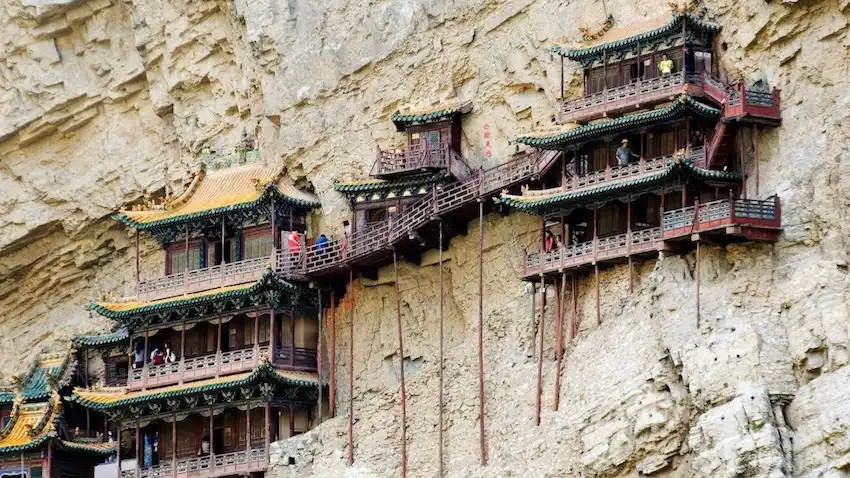The Hanging Temple of Hengshan: A Marvel of Ancient Chinese Engineering
Perched precariously on the side of Hengshan Mountain in Shanxi Province, China, the Hanging Temple, or Xuankong Temple, is a spectacle of architectural brilliance and spiritual significance. This ancient temple, defying gravity and time, clings to the cliff face nearly 75 meters above the ground, offering breathtaking views and a unique spiritual experience. Dating back over 1,500 years to the Northern Wei Dynasty, the Hanging Temple not only serves as a place of worship but also as a stunning testament to the ingenuity of ancient Chinese builders.

Architectural Wonder
The Hanging Temple stands out not only for its precarious position but also for its structural ingenuity. Built into a natural concave in the cliff, it has been supported by oak crossbeams fitted into holes chiseled into the rocks. The main supportive structure is hidden inside the bedrock, giving the illusion that the temple is hanging in mid-air. This architectural technique has ensured the temple’s stability over centuries, despite its seemingly fragile perch.
The temple’s layout is vertically oriented, utilizing the limited space of the cliff face efficiently. It features over 40 rooms connected by a maze of passageways, showcasing an intricate design that balances aesthetic beauty with practical functionality. The temple integrates elements of Buddhism, Taoism, and Confucianism, which is reflected in its statues and the murals within its halls.
Cultural and Spiritual Significance
The Hanging Temple not only is an architectural wonder but also holds significant cultural and spiritual value. It is one of the few existing temples that incorporate the three major traditional Chinese religions: Buddhism, Taoism, and Confucianism. This coexistence symbolizes a traditional harmony among different faiths in China and offers a unique pilgrimage site where followers of these religions can worship side by side.
Visiting the Hanging Temple

Visitors to the Hanging Temple can explore various halls and pavilions that house over 80 sculptures made of stone, wood, and metal, representing deities from the three religions. The experience of walking through the narrow corridors, with only a wooden railing separating visitors from the steep drop of the cliff, is both thrilling and contemplative.
The best times to visit the Hanging Temple are during spring and autumn, when the weather is mild, and the scenic beauty of Hengshan Mountain is at its peak. However, visitors are advised to arrive early in the morning to avoid the crowds and to fully appreciate the quietude and spiritual ambiance of the temple.
Conservation Challenges
The Hanging Temple’s unique location and construction also present significant conservation challenges. Over the years, the temple has faced threats from erosion, weathering, and the impact of tourism. Ongoing efforts by Chinese authorities and international organizations aim to preserve this ancient site while keeping it accessible to the public.

A Testament to Human Spirit and Ingenuity
The Hanging Temple of Hengshan is a remarkable example of human creativity and spiritual devotion. Its construction not only demonstrates extraordinary engineering skills but also represents a deep integration of cultural values and religious harmony. As one of the great wonders of ancient Chinese architecture, the Hanging Temple continues to draw admiration from around the world, captivating all who visit with its beauty and its defiance of the natural elements.




















